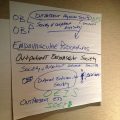The office-based laboratory (OBL) industry has proliferated over the past decade as surgical cases have increasingly migrated from inpatient to outpatient surgical settings, including OBLs, ambulatory surgery centers and infusion centers. Although many physicians and patients prefer to provide and receive care in an OBL setting because it provides a high quality, lower cost and convenient alternative to receiving care in a hospital, the OBL industry is nonetheless under attack on a variety of fronts. Governmental and commercial payor reimbursement for OBL procedures has declined substantially over time, and there have been lawsuits, governmental investigations and news articles that have been critical of care provided in OBLs. These issues have generated headwinds for this young but growing industry. It is therefore important for physicians and investors alike interested in developing an OBL to be aware of the complex landscape of laws and regulations that apply to OBLs. This article provides an overview of key legal, corporate, tax, financial and structural considerations for operators to be aware of before opening an OBL.
The office-based laboratory (OBL) industry is under attack on a variety of fronts, but there are steps that operators can take to mitigate legal risk associated with healthcare-related lawsuits and investigations. In July 2022, the U.S. Attorney’s Office for the Eastern District of New York filed a civil complaint against Fresenius Vascular Care, Inc. (FVC) alleging that the company performed unnecessary procedures on dialysis patients at nine centers and billed federal health care programs for those procedures in violation of the Federal False Claims Act. [CR]
1 U.S. ex. rel. John Pepe, M.D. and Richard Sherman, M.D. v. Fresenius Vascular Care, Inc. (complaint available at https://www.justice.gov/usao-edny/pr/united-states-files-claims-alleging-fresenius-vascular-care-inc-defrauded-medicare-and ).
In October 2023, the New York State Attorney General jointly filed with the attorneys general of Georgia and New Jersey an additional complaint alleging that FVC knowingly subjected end-stage renal disease patients, including elderly people, people of color, and low-income individuals, to unnecessary and invasive procedures to increase its revenues. [CR]2 The States of Georgia, New Jersey and New York ex. rel. John Pepe, M.D. and Richard Sherman, M.D. v. Fresenius Vascular Care, Inc., American Access Care Physician, PLLC, Access Care Physicians of NJ, LLC, New Jersey Interventional Associates, LLC, Snapfinger Vascular Access Center, LLC, Fresenius Vascular Care Augusta, LLC, American Access Care of Atlanta, LLC, and Gregg Miller, M.D. (complaint available at https://ag.ny.gov/sites/default/files/court-filings/fresenius-complaint-in-intervention.pdf ).
In December 2022, the United States intervened in a Federal False Claims Act whistleblower case in the Southern District of Arizona against Modern Vascular and many of its principals, affiliates and investor physicians and podiatrists. [CR]
3 U.S ex. rel. Radhakrishnan, et al., ex rel. Terry, et al., ex rel. Katherine Diggins, et al., v. Yury Gampel, Modern Vascular of Glendale, LLC Modern Vascular LLC (complaint available at https://www.justice.gov/opa/pr/united-states-files-false-claims-act-complaint-against-chiropractor-modern-vascular-office ).
The government alleged that Modern Vascular and its founder, Yury Gampel, engaged in a fraudulent scheme whereby physicians and podiatrists were encouraged or permitted to invest in OBLs, or affiliated management service organizations, in exchange for making referrals to OBLs.In addition to these legal actions, certain news outlets have focused a critical eye on problematic practices in the OBL space. For example, the New York Times published an article in July 2023 highlighting alleged overuse of atherectomy devices in the treatment of patients with peripheral artery disease leading to amputations and other complications. [CR]
4 See They Lost Their Legs. Doctors and Health Care Giants Profited , New York Times (available at https://www.nytimes.com/2023/07/15/health/atherectomy-peripheral-artery-disease.html ).
Further, ProPublica has published a series of articles critical of the shift to outpatient vascular care and accompanying concerns about physicians allegedly performing unnecessary, costly and risky procedures. [CR]5 See Arterial Motives. The Big Business of Clogged Arteries , ProPublica (article series available at https://www.propublica.org/series/arterial-motives ).
One recent ProPublica article commented that “experts fear patients are being caught up in a new era of profit-driven procedure mills, in which doctors can deploy any number of devices in the time it takes to drill a tooth and then bill for the price of a new car.” [CR]6 See In the “Wild West” of Outpatient Vascular Care, Doctors Can Reap Huge Payments as Patients Risk Life and Limb , ProPublica (available at https://www.propublica.org/article/maryland-dormu-minimally-invasive-vascular-medicare-medicaid ).
Even though many patients prefer to receive surgical care in an OBL setting because it is often more convenient and cost effective than receiving care in an ASC or hospital outpatient department (HOPD), the OBL industry is currently under scrutiny from payors, other providers and the media. It is therefore more important than ever for OBLs to focus on providing high quality care in an ethical and compliant manner, and there are a variety of topics that prospective and current OBL owners should consider when structuring, syndicating and operating an OBL.
- 1.
Consider Building an OBL to ASC Standards . Regardless of the specific care delivery setting, Medicare treats all OBLs the same for purposes of reimbursement. Services performed in an OBL are reimbursed by Medicare under the Medicare Physician Fee Schedule (MPFS) and claims are submitted using Place of Service (POS) code 11; while services performed in a Medicare-certified ambulatory surgery center (ASC) are reimbursed by Medicare under the Hospital Outpatient Prospective Payment System and Ambulatory Surgical Center Payment System (OPPS/ASC) using POS code 24. Although the Medicare reimbursement differential for surgical services performed in an OBL and ASC has been minimized over recent years, there remain notable differences in reimbursement for certain surgical services. Such site-specific payment differences, however, may be eliminated if the Centers for Medicare & Medicaid Service (CMS) implements site-neutral payment policies across outpatient care delivery settings.
For example, on April 26, 2023, the House Energy and Commerce Committee Health Subcommittee held a legislative hearing to consider a variety of bills directing CMS to implement site-neutral payments based on where services are most commonly provided. [CR]
7 Society of Interventional Radiology (SIR) Open Forum, eviCore Clinical Guidelines Peripheral Vascular Intervention – Version: 1.0.23.
The bills would direct CMS to identify whether items and services within an ambulatory payment classification (APC) are more commonly performed in the OBL, ASC or HOPD setting. Where items and services within an APC are most commonly performed in an ASC setting, the generally higher HOPD payment rates would be aligned to ASC payment rates. Services furnished in an OBL setting would continue to be paid under the MPFS. Where services within an APC are most commonly performed in an OBL setting, HOPD and ASC payment rates would be aligned with the typically lower MPFS non-facility rates.
Parties wishing to hedge against reimbursement uncertainty often consider building an OBL to ASC standard–including building, fire and life safety code requirement. However, doing so can be an expensive endeavor and can cost upwards of four times the cost of building an similarly-sized OBL. It also may not be possible to build to ASC standards in some buildings due to structural considerations, while other states may limit the number and type of ASCs in a given geography under certificate of need laws. However, the incremental costs of building to ASC standards from the start can be trivial when compared against later retrofitting a space to ASC standards.
- 2.
Consider Your Strategic Goals . OBLs are frequently organized either as a department of a “group practice” as defined under 42 C.F.R 411.352 or as a separate stand-alone clinic. Although there is not a “correct” way to structure an OBL, it is important to understand the benefits and drawbacks associated with each organizational structure, including the following ( Table 1 ):
Table 1
Common Organizational Structures for OBLs
OBL Organized as a Group Practice
OBL Organized as a Clinic
Strategic Goal
Used by group practices to foster revenue enhancement, group independence, succession planning and to support physician recruitment
Used as a collaborative tool by physicians in a geographic market to provide complimentary surgical services (e.g., dialysis vascular access, peripheral arterial disease, venous embolization, etc…).
Corporate Organizational Structure
Often organized as a professional corporation or professional limited liability company
Often organized as a professional corporation or professional limited liability company; alternatively may be structured using an MSO-friendly PC structure to allow for non-physician investment in an affiliated management services organization
Start-Up
If a group practice has been established, then starting up an OBL may be simple if operated under the group practice’s tax identification number
Time-consuming to organize a new entity, syndicate equity and enter into new organizational documents
Commercial Payor Contracting
If an established group practice already has commercial payor contracts, then a group practice can typically either perform surgical services under its existing payor contract or enter into limited payor negotiations to add new codes (typically takes 0-3 months)
Clinics will typically need to engage in payor contracting with commercial payors, which may take longer in some states and/or may be very difficult if a panel is closed to certain provider types (typically takes 3-9 months)
Working Capital Requirements
Limited, due to ease of payor contracting and existing organizational and equity structure
Extensive, due to payor contracting challenges
Fair Market Value Investment
With certain exceptions, investors are not required to purchase equity in a group practice in exchange for fair market value consideration
Investors are required to purchase equity in an OBL that does not qualify as a group practice in exchange for fair market value consideration
Performing Stark Law Designated Health Services (DHS) (e.g., diagnostic imaging)
May be performed and billed within the group practice, subject to satisfying the Stark Law in-office ancillary services exception or another exception
Difficult for an entity to perform or bill for DHS since a clinic typically can’t satisfy the Stark Law in-office ancillary services exception
Non-Physician Investment
Challenging to structure to allow non-physicians to directly invest in a group practice, particularly in corporate practice of medicine (CPOM) states. May require significant restructuring of a practice that can result in adverse income tax consequence for a practice’s owners
Direct non-physician investment may be permitted in non-CPOM states; management service organization-” friendly physician” model may be used to allow non-physician investment in an affiliated management services organization in CPOM states 
Stay updated, free articles. Join our Telegram channel

Full access? Get Clinical Tree





